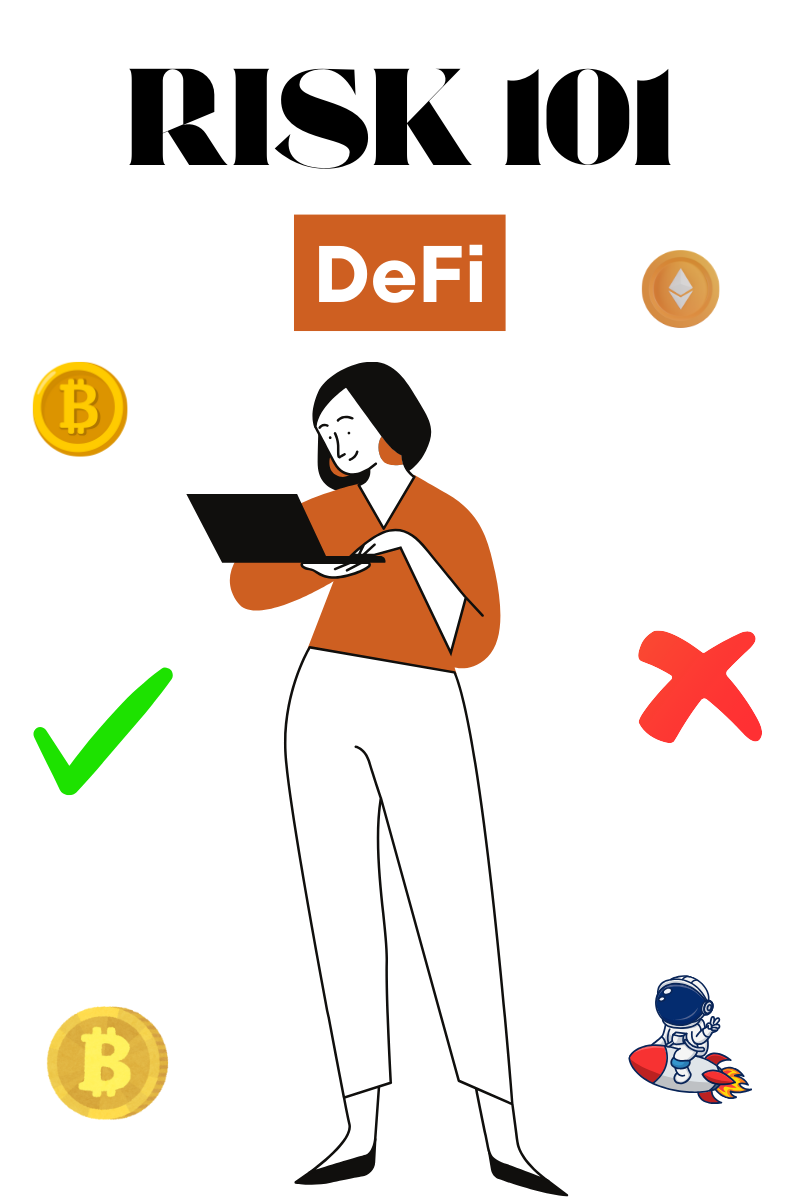Vitalik took a risk while creating Ethereum, patients take risks when undergoing surgical operations, the founding fathers took a risk while fighting for independence, customers take risks when they save their money in the bank, and you take a risk when you step out of your house every day. Risks are an inherent part of life. This phenomenon also manifests in the DeFi ecosystem, where financial instruments are traded extensively. Due to this, there is sure to be fear among users regarding hacks and losses, which ultimately leads to dwindling morale in the Web3 ecosystem.
We all take risks and we cannot stop living just because these risks might bring disastrous consequences. Instead of living in fear of what risks might befall us, we can try our best to put precautions in place that will prevent falling into some risks or invest in tools that will minimize their impact.
Traditional Finance Risks
When it comes to risks in the traditional finance sector, we uncover abnormalities that come as a result of stifling the customer and making decisions that do not best represent the client. The traditional system does this by performing activities like putting most costs that are used to run the finance system on the buyers, unwarranted cuts, and uncalled-for taxes. This often leaves the user at a loss and with less money than they initially put in as investment.
Another risk associated with the traditional finance system is how users do not have control of their money. The finance system holds onto funds and makes the customer go through rigorous loopholes in order to get it back. Sometimes, these traditional finance organizations can even make wrong investments with users' money, which causes users to lose all around.
Lastly, when it comes to the traditional finance system, users are rarely allowed to make decisions concerning what happens to their investment. This is often done by managers who want to do what is in the best interest for them and that of the company.
DeFi and its Risks
DeFi is the abbreviation for Decentralized Finance. It is a thriving platform that provides endless financial instruments on the blockchain. It is permissionless and is ushering users to the new age of finance which is equitable and where everyone has control over their money. DeFi encourages peer-to-peer transactions and allows users to make decisions that will favor them and favor the health of the world at large.
However, everything with advantages often has its disadvantages. The disadvantages of DeFi can be split into 5 categories, which are:
-
Technical risks: These are risks that are associated with the technological aspects of DeFi. They concern all the aspects that deal with bugs and the technology that runs it. It is the chance that the underlying blockchain infrastructure may be corrupted. This corrupted technology can lead to vulnerabilities in the blockchain which might be hard to detect until it's too late. Risks under these categories are smart contract risks and protocol risks.
-
Operational risks: These risks are related to the day-to-day running and management of DeFi protocols. As the DeFi ecosystem continues to grow, new organizations will also start coming up and new processes along with them. Operational activities encompass the human element and organizational structures behind these systems. If operations are not developed properly, risks can arise from poor management, inadequate processes, or human error. For instance, a protocol might face issues if its development team lacks proper coordination or if there are flaws in the decision-making process. These risks can lead to delayed upgrades, inefficient resource allocation, or even security vulnerabilities if not properly addressed.
-
Liquidity risks: These are centered around the availability and flow of assets within DeFi protocols. Liquidity risk refers to the possibility that a protocol may not have sufficient funds to meet withdrawal demands or facilitate trades. This can lead to slippage, where large trades significantly impact asset prices. Impermanent loss is another crucial aspect of liquidity risk, particularly in automated market makers (AMMs). It occurs when the price ratio of assets in a liquidity pool changes, potentially leading to losses for liquidity providers compared to simply holding the assets.
-
Procedural risks: These risks are associated with the interconnected nature of DeFi and the reliance on external data sources. Risks under these are: Composability risk, which arises from the modular nature of DeFi, where protocols often interact with or depend on other protocols. If one protocol in this chain fails, it can have a cascading effect on others.
Another risk under this category is Oracle risk, which stems from the reliance on external data providers for price feeds and other crucial information. Inaccurate or manipulated oracle data can lead to significant losses.
Finally, Decentralized governance risk relates to the potential for misaligned incentives or malicious actors influencing protocol decisions through governance token voting.
-
Regulatory risks: These encompass the legal and compliance challenges faced by DeFi protocols. As the regulatory landscape for cryptocurrencies and decentralized finance continues to evolve, protocols may face sudden changes in legal status or compliance requirements. This uncertainty can lead to market volatility and user hesitation. External risks also fall under this category, including geopolitical events, changes in global economic conditions, or shifts in public perception that can impact the entire DeFi ecosystem. These risks are often unpredictable and can have far-reaching consequences on protocol adoption and asset values.
Ways To Manage These Risks
Just because there are risks doesn't mean users should avoid the technology. DeFi is still the best technology built so far when it comes to finance, so instead of shunning or living in fear, there are multiple ways in which users can approach DeFi risks, manage holdings securely, and still live the best life.
1. Being Good Custodians of Funds: Users need to protect their funds and investments appropriately. As we all know, wallets are users' identity in the DeFi space. Funds and investments can be protected by never sharing seed phrases if you use a digital wallet. Also, if users have a hefty portfolio, they should consider using hardware wallets. It's like having a personal vault for your crypto – sure, it might seem like overkill, but you'll thank yourself later.
2. Use protocols that are tested and trusted: Users should avoid jumping into just any protocol that promises high returns or looks like they have good potential. Stick to the ones that have been battle-tested and have a solid reputation. It's tempting to chase those juicy yields, but remember, if it looks too good to be true, it probably is.
Never provide liquidity or make investments without doing your own research (DYOR): It is advisable not to just ape into liquidity pools because your favorite influencer said so. Also, before making investments, there should be a certain investigation process. As a user, you need to dive deep, understand the mechanics, and assess the risks. It is hard-earned money being invested, after all – treat it with the respect it deserves.
3. Don't click on just any link: Develop a radar for scams and be wary of hackers. If a call to action is generating FOMO, or looks like it is using social engineering skills to make you feel rushed then it's probably a scam. Another way for users to be safe is to practice financial security by not sharing their portfolio online. There is absolutely no need for users to paint a target on their digital behind. Also, those sketchy-looking projects promising 1000% APY? Yeah, users should give those a wide berth.
4. Join communities that are close-knit: Joining communities and following trusted sources in the space can help prevent DeFi risks as there will be notifications. Even in the DeFi space, experience is often the best teacher. However, this doesn't mean you also have to go through it. When a breach happens in the ecosystem, those who fall victim to it often alert their communities or seek help from trusted individuals in the space. Once this happens, their entire community and network is aware of it, therefore users benefit from being in those types of communities. An example is this tweet where a security researcher alerted users about some scams in the Web3 space.
5. Insurance: While the aforementioned protection strategies are necessary, they are not foolproof as DeFi is still young and constantly evolving. If users really want to live freely without biting their fingers every minute thinking, about the volatility of the DeFi space, then they need protection. Speaking of protection, Nexus Mutual is doing an absolutely stellar job in this space. Nexus Mutual is leading the charge in DeFi insurance, offering coverage for smart contract failures, custodian risks, and even specific yield-bearing strategies. Their decentralized model aligns perfectly with DeFi principles.

Remember, managing risks in DeFi isn't about eliminating all possible dangers – it's about being smart, staying informed, and taking sensible precautions. With these strategies, users can navigate the exciting world of DeFi with confidence, reaping the rewards while minimizing the pitfalls. The world of DeFi is an exciting terrain, make sure to enjoy it.





评论 (0)